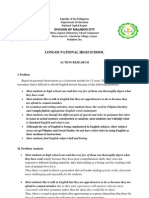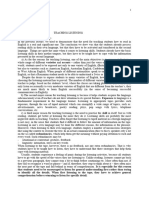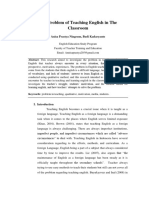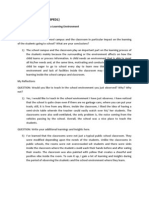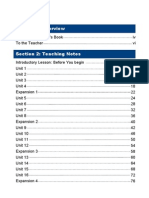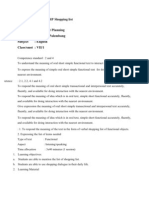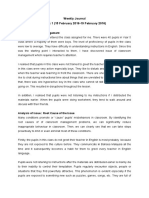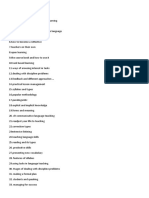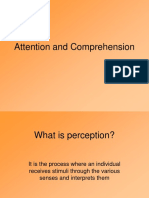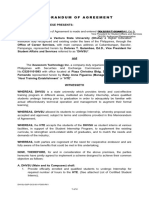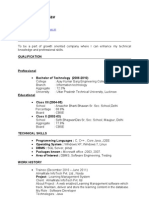5 National VTTN ELT Conference 2009 Hanoi: Improving Weak Student'S Listening Skills
5 National VTTN ELT Conference 2009 Hanoi: Improving Weak Student'S Listening Skills
Uploaded by
Jajati SatpathyCopyright:
Available Formats
5 National VTTN ELT Conference 2009 Hanoi: Improving Weak Student'S Listening Skills
5 National VTTN ELT Conference 2009 Hanoi: Improving Weak Student'S Listening Skills
Uploaded by
Jajati SatpathyOriginal Title
Copyright
Available Formats
Share this document
Did you find this document useful?
Is this content inappropriate?
Copyright:
Available Formats
5 National VTTN ELT Conference 2009 Hanoi: Improving Weak Student'S Listening Skills
5 National VTTN ELT Conference 2009 Hanoi: Improving Weak Student'S Listening Skills
Uploaded by
Jajati SatpathyCopyright:
Available Formats
5th National VTTN ELT Conference 2009 Hanoi
IMPROVING WEAK STUDENTS LISTENING SKILLS Tran Van Co,
ELT Specialist Binh Dinh DOET I. The problem of teaching listening A new series of English textbooks for students have been used in schools in Viet Nam for some years and there has been a lot of feedback from teachers who have used them. One of the problems they face is that they are not satisfied with their teaching of listening. Although they have been trying to find ways to make their listening activities more effective, the results they obtain are not as good as what they want. Some conclusions have been made to explain the situation. Many teachers stated that the new textbooks which contain a large amount of knowledge, hinder the students learning. Others stated that they have many weak students who lack vocabulary, grammatical knowledge and have poor pronunciation, reduce classroom learning potential learning environment. Sometimes the problem originates from the teachers themselves. Many teachers think that if they teach in a class with many weak students, they cant spend a lot of time teaching listening. They do not use all of activities they had designed when writing lesson plans because if they do, the weak students cant keep up. II. What the teachers know about teaching listening. All qualified English language teachers know that a listening activity consists of three stages and each stage has its own purpose. There are many different activities to use in each stage. The most important listening skills they should train the students to gain are listening for gist and listening for specific information. They help the students to focus on the information required to finish the listening tasks. What the teachers do (as mentioned) only work well in the class where there are many good students. Many teachers have the opportunity to attend the workshops on teaching listening. They are trained to use lots of techniques for each stage of the listening. They tried them out at the workshop in the presence of their peers. They received feedback from fellow teachers and useful tips from the trainers. After the workshops, the teachers went back to their schools with the eagerness to apply what they had learnt into their own language classes. Some classes were successful while others still had problems. There were no improvements from the weak students when they listened to the tape or did the activities instructed by the teacher. This shows that no matter how effective the listening activity itself can be, teachers and students are still facing obstacles in the classroom.
III. What we should do to help develop listening skills in weak English language students. A. Issues relating to the language learners After finding out that our teachers used the listening techniques they were trained in the workshop, but not successfully in every language class, we looked into other issues relating to language learning which have been discovered so far. 1. Psychology We should take into account the psychology of learning habits and skills. Certain psychological factors should be considered such as memory. We should consider their mental condition, their ability. 2. Motivation and learning - Students learn well if they are well-motivated. We can motivate even unmotivated students. 3. Learning styles - Visual learners learn through seeing. - Auditory learners learn through listening. - Tactile/Kinaesthetic learners learn through moving, doing and touching. 4. Types of Multiple Intelligence - Visual/Spatial Intelligence: ability to perceive the visual. - Verbal/Linguistic Intelligence: ability to use words and language. - Logical/Mathematical Intelligence: ability to use reason, logic and numbers. - Bodily/Kinaesthetic Intelligence: ability to control body movements and handle objects skilfully. - Musical/Rhythmic Intelligence: ability to produce and appreciate music. - Interpersonal Intelligence: ability to relate and understand others. - Intrapersonal Intelligence: ability to self-reflect and be aware of ones inner state of being. It is believed that each person has at least 3 or 4 types of intelligence. So we cannot think that weak learners are unintelligent people. 5. Weak students Weak students are the students who usually lack basic knowledge or skills, have difficulty in comprehension. Some teachers say that in the classroom the weak students often lack concentration. Weak students are easily confused so in the classroom the teacher should give clear, step by step, instructions. The teacher should anticipate that weak students may need extra help, extra explanations. B. What we do to help weak students in Listening. 1. At the pre-listening stage: have more time at the pre-listening stage by shortening the post-listening stage. At this stage, we carefully prepare the lesson reading the tapescripts and using The Teaching Listening Checklist (see Appendix 1). The following activities can be used based on the content of each lesson:
- Revise vocabulary. - Revise grammatical structure. - Create a gap-filling task or other tasks based on the tapescript. - Train listening skills. (see Appendix 2) - Train microskills for listening. (see Appendix 3) - Give some listening tips.
2. At the while-listening stage: - Remember to tell the aim of listening before you let the students to listen to the tape. - Write a very easy question so that the students can answer after the first listening. (to encourage them to listen, to make them have a feeling of success). - Write more additional questions to the listening tasks to make them easy for the students. - Ask the students to guess before they listening to the tape. (Do not say what they guess is wrong or right, ask why they guess so if necessary). - Be flexible when getting the students to listen to the tape. Read the listening text if you find it helpful to your students. AN EXAMPLE OF LISTENING LESSON FOR WEAK STUDENTS * Unit 1 Listening, Task 1 The 10th Form Textbook. The following is the listening Task 1 (page 16) from the Textbook and Tape script.
* Task 1: You will hear Mr Lam, a cyclo driver, talk about his morning Activities. Listen to his talk and number the pictures in their correct order.
* Tapescript Hello everyone, my name is Lam. I'm a cyclo driver in Ho Chi Minh City. I usually have a busy working day. I get up at five thirty in the morning. I start work at six. My first passenger is usually an old man. I take him from District 1 to District 5. After I drop him at a cafe near Ho Chi Minh City College of Education, I pedal to Thai Binh Market. My next passenger is a lady who does shopping there every two days. I help her put all her purchases into the cyclo and then take her to her shop in Tran Hung Dao Street. At about ten thirty I ride off toward Nguyen
Thi Minh Khai School. There I park my cyclo, chat with some of my fellows and wait for my third passengers. They are two school pupils, a girl and a boy. I take them home. At twelve I have lunch at a food stall near Ben Thanh Market. After lunch, I park my cyclo under a tree, take a short rest and then continue my afternoon's work. In The Tieng Anh 10 textbook in Viet Nam, activities in the three stages are ready for the teachers to use. The problem is that many students are still weak at learning English, particularly, listening. Sometimes they are fed up with listening activities because they are forced to listen to stories or conversations from the cassette players, and grasp nothing. Sometimes they feel happy in listening activities, because they just pretend to do some activities the teacher asks them to do, pretend to listen to the tape carefully, finish one or two tasks in the textbook and wait for the answers to the tasks the teacher tell them or someone of their classmates who is lucky to get the teachers book. In the Listening lesson of Unit 1 The 10th form Textbook currently used in upper secondary schools in Viet Nam, the teacher has to go through the two tasks. For Task 1, the students are asked to listen and number the pictures in the correct order. We can do the following activities to help the students complete the task successfully and develop further their language skills. A. At the pre-listening stage: 1. Revise vocabulary: get up, old man, a lady, fellows, school pupils, take a short rest. Use the pictures in the textbook to help the students to find out the Vietnamese equivalence. 2. Helps the students to find out the Vietnamese equivalence of other English words given in the task: district, routine, office, pedal, purchase, drop, ride, park, food stall, passenger. Note: After the two above activities, students can obtain more words needed for listening to do the task. 3. Ask the students to pay attention to some clues: + The time: five thirty, six, after, twelve. + The words: first passenger, next passenger, third passengers. 3.a. Ask the students to use the given words to complete the spaces in the following sentences (The sentences are extracted from the listening text): work get up park food stall ride off a. I at five thirty in the morning. b. At about ten thirty I . toward Nguyen Thi Minh Khai School. c. I start .. at six. d. At twelve I have lunch at a .. near Ben Thanh Market. e. After lunch, I . my cyclo under a tree. 3.b. Tell the students that the above sentence belongs to a paragraph about the daily routine of a cyclo driver, but they are not in their correct order. Ask the students to put them. (You can use Vietnamese for the instruction if you find it helpful and you want to save the time in case your students do not understand the instruction in English). 4. Ask the students to put the following sentences in their correct order (The sentences are extracted from the listening text): a. My next passenger is a lady who does shopping there every two days.
b. My third passengers are two school pupils, a girl and a boy. c. My first passenger is usually an old man. Note: The activities 3.b and 4 serve to help the students to be familiar with the ordering task. 5. Ask one student to mime what a cyclo driver does everyday. Note: This activity will change the atmosphere in the classroom because it is funny and it helps the tactile learners to show themselves. Activities 1, 2 is for visual learners or students having verbal intelligence. Activities 3.b and 4 are for students having logical intelligence. A. During the listening stage: - Ask the students to listen to the tape for the first time and answer the following questions: The listening text is about . A. a cyclo driver B. a school student C. a college lecturer. - For the second or third, or fourth listening the teacher should help the students to finish the listening task in the textbook. (See Appendix 4)
IV. Conclusion Our way of teaching listening is that we change our attitudes towards the students ability in listening, prepare the lesson plans carefully in class, exploit the transcript, try our best to lead the listening lessons in a flexible way and study other issues in relation to teaching and learning such as motivation, psychology and learning styles. You, certainly, have your own difficulties in teaching listening and you have your own way of teaching listening and helping your students to listen in English. But one more thing I would like to say is that do not think or say about your difficulties in teaching listening. When you think you have difficulties, you cannot do anything because everything will be difficult for you. Identify the difficulties you have and your students have and find the way to overcome those.
References - In service teacher training materials by MOET of Viet Nam. - Introduction to TESOL Teaching Listening.htm. - A Profile of the Slow Learner Teacher Education Project (U.S.A). - English Now Issue 9, November 2004. - Listening in Action, Michael Rost, Prentice - Hall, 1991. - Mac Yin Mee (University of Malaysia) Teaching Listening: An overview. The English Teacher. Vol XIX July, 1990. - Adrian Tennant Listening matters: Process Listening. OnestopEnglish. - Miriam Greif - Weak Learners in High School Must they read? Appendix 1: TEACHING LISTENING CHECKLIST Tran Van Co - ELT Specialist - Binh Dinh DOET adapted the following from Listening in Action, Michael Rost, Prentice - Hall, 1991 for training. (Extracted from English Now Issue 9) When teaching Listening, do you help your students? 1. discriminate between sounds 3. identify grammatical groupings of words 4. connect linguistic cues to intonation and stress 5. use their background knowledge and context to predict and to confirm meaning 6. recall important words and ideas 8. think about their relationship to the speaker 10. organize what they hear 12. know their reason for listening 14. guess unknown words and expressions Appendix 2: LISTENING SKILLS - Listening for general information. - Listening for specific information - Listening for details - Recognising words. 7. deal realistically with the situation 9. get clarification 11. plan their response 13. pay attention to the key content words 15. activate what they know about the topic 2. recognize words
- Listening for the main idea - students listen to identify the overall ideas expressed in the whole recording. - Listening for details students listen for groups of words and phrases at sentence level. - Listening for specific information students listen for particular information at word level. - Predicting students try to guess key information contained in the recording before they listen. - Inferring meaning students listen to identify the difference between what the speaker says and what they actually mean. - Identifying emotion students listen to identify the mood of certain speakers. - Listening for opinions students listen to identify the attitude of certain speakers. - Inferring relationships students listen to identify who the people are in the recording and what the relationship is between them. - Recognizing context students listen to aural and contextual clues to identify where the conversation takes place, who is speaking, etc.
Appendix 3: MICROSKILLS OF LISTENING COMPREHENSION 1. Retain chunks of language of different length in short term memory. 2. Discriminate among the distinctive sounds of English. 3. Recognize English stress patterns, words in stressed and unstressed positions, rhythmic structure. 4. Recognize reduced forms of words. 5. Distinguish word boundaries, recognize a core of words, and interpret word order patterns and their significance. 6. Process speech at different rates of delivery. 7. Process speech containing pauses, errors, corrections, and other performance variables. 8. Recognize grammatical word classes (nouns, verbs, etc.), systems (e.g. tense, agreement, pluralisation), patterns, rules, and elliptical forms. 9. Detect sentence constituents and distinguish between major and minor constituents. 10. Recognize that a particular meaning may be expressed in different grammatical forms. 11. Recognize cohesive devices in spoken discourse. 12. Recognize the communicative functions of utterances, according to situations, participants, goals. 13. Inter situations, participants, goals using real world knowledge. 14. From events, ideas, etc, described, predict outcomes, infer links and connections between events, deduce causes and effects, and detect such relations as main idea, supporting idea, new information, given information, generalization, and exemplification. 15. Distinguish between literal and implied meanings. 16. Use facial, kinesics, body language, and other nonverbal clues to decipher meanings. 17. Develop and use a battery of listening strategies, such as detecting key words, guessing the meaning of words form context, appeal for help, and signalling comprehension of lack thereof. Appendix 4: Have the students listen to the tape When the students take the listening test, they listen to the tape twice and then use what they have heard to do the test. After some days the students will be informed the test result. If the teacher do the same in the class, that means he does not teach but test listening. In the listening lesson, the teacher has to finish the lesson in 45 minutes with the two listening tasks in the textbook. If we ask the teachers how many times they should let the students to listen to the tape we can get various answers. Some of them say at least three times, the others say more than three or as many as possible. The ways they do are as follow: 1. The teacher lets the students listen to the tape twice and ask them to do the listening task 1 in the textbook and then call out the answers to the questions. If the students do not give the correct answers, the teacher lets them listen to the tape more. 2. The teacher lets the students listen to the tape once and asks the students to do the listening task 1 in the textbook. And then he lets them to listen to the tape the second time, asks the students to do the task. After the third time of listening the teacher starts to ask the students to give the answers. 3. The teacher lets the students listen to the tape three times in succession and then asks the students to do the listening task 1.
The same steps are repeated for the listening task 2. Nothing wrong with the above mentioned steps the teachers use and the times they let the students listen to the tape. Three or four times of listening are all helpful providing that the students listening skills are developed. What we want to discuss here is that if you do not help the students to listen (if you are not the helper) they cannot hear anything. (Tran Van Co) ___________________________________
You might also like
- Improving Weak Students in Listening SkillsDocument8 pagesImproving Weak Students in Listening Skillskggan8678No ratings yet
- Action Research For Filipino English TeachersDocument7 pagesAction Research For Filipino English TeachersDezmein100% (5)
- Teaching English to Speakers of Other LanguagesFrom EverandTeaching English to Speakers of Other LanguagesRating: 3 out of 5 stars3/5 (1)
- By Inge DanielsDocument3 pagesBy Inge DanielsJude Valdez ArnaizNo ratings yet
- Teaching ListeningDocument7 pagesTeaching ListeningCristina B.No ratings yet
- Câu hỏi ôn tập môn lý luận dạy tiếng Anh l1Document13 pagesCâu hỏi ôn tập môn lý luận dạy tiếng Anh l1nmaianh421No ratings yet
- Interview Question TypesDocument6 pagesInterview Question Typesapi-295499931No ratings yet
- Lesson 2. Teaching Oral Communication Skills (Listening and Speaking)Document6 pagesLesson 2. Teaching Oral Communication Skills (Listening and Speaking)BlodiMerNo ratings yet
- Lecture 10. Teaching ListeningDocument3 pagesLecture 10. Teaching ListeningarailymoooNo ratings yet
- Grammar TranslationDocument3 pagesGrammar TranslationHoa PhànNo ratings yet
- Peer-TeachingDocument4 pagesPeer-TeachingTiên Lê Thị ThảoNo ratings yet
- TasksDocument8 pagesTasksapi-302345809No ratings yet
- Classroom Observation Assignment-Form 1-Adem ErtunaDocument3 pagesClassroom Observation Assignment-Form 1-Adem Ertunaapi-357822494No ratings yet
- Listening Subskills 2Document5 pagesListening Subskills 2Ngân TrầnNo ratings yet
- Module 3 Challenging Listening and SpeakingDocument3 pagesModule 3 Challenging Listening and SpeakingMajlinda QosjaNo ratings yet
- Observation StageDocument3 pagesObservation StagemakitzzzNo ratings yet
- Learning Journal 2Document9 pagesLearning Journal 2Kiki LatifahNo ratings yet
- Observation TableDocument4 pagesObservation Tableapi-302003110No ratings yet
- MDD 1Document5 pagesMDD 1api-300475439No ratings yet
- Theories of Language Learning and TeahingDocument7 pagesTheories of Language Learning and TeahingMiro MiroNo ratings yet
- LEARN-VS-TEACHDocument4 pagesLEARN-VS-TEACHBảo KimNo ratings yet
- Improving Students' Listening Skill by Using Songs: A. BackgroundDocument20 pagesImproving Students' Listening Skill by Using Songs: A. BackgroundSafitriNo ratings yet
- Anisa Prastya Ningrum - 2013042056 - Academic Writing UASDocument13 pagesAnisa Prastya Ningrum - 2013042056 - Academic Writing UASyantopendemNo ratings yet
- Classroom Observation Assignment-Form 1 Recep BatarDocument3 pagesClassroom Observation Assignment-Form 1 Recep Batarapi-290710546No ratings yet
- Khoa Ngoại Ngữ: Trường Đại Học Văn HiếnDocument13 pagesKhoa Ngoại Ngữ: Trường Đại Học Văn HiếnPhương Trần Thị ThanhNo ratings yet
- Assignment Topic 12 TEFL - Andi NurfitryaniDocument3 pagesAssignment Topic 12 TEFL - Andi NurfitryaniAndi NurfitryaniNo ratings yet
- CiSELT Assign2Document22 pagesCiSELT Assign2TishaliniNo ratings yet
- (PG36-G10-Final Assignment) - 21046937nguyen Thi Anh TuyetDocument9 pages(PG36-G10-Final Assignment) - 21046937nguyen Thi Anh TuyetNGUYỄN THỊ ÁNH TUYẾTNo ratings yet
- Observation Sheet - High SchoolDocument10 pagesObservation Sheet - High Schoolapi-252636190No ratings yet
- Field Study FinalDocument9 pagesField Study FinalBianca ThereseNo ratings yet
- Educ 202 Artifact Classroom Observation I Fixed ErrorsDocument11 pagesEduc 202 Artifact Classroom Observation I Fixed Errorsapi-571559130No ratings yet
- Observation NotesDocument10 pagesObservation Notesapi-286083411100% (1)
- Tugas EylDocument18 pagesTugas EylMariya Subagiyo WezNo ratings yet
- Humanising Language Teaching Magazine For Teachers and TeachDocument4 pagesHumanising Language Teaching Magazine For Teachers and TeachHidayah SallehNo ratings yet
- 7 Listening TechniquesDocument25 pages7 Listening TechniquesThomas SembodoNo ratings yet
- Task 2Document3 pagesTask 2api-294972418No ratings yet
- A. The Background of The ReportDocument8 pagesA. The Background of The ReportAyu Delisa PutriNo ratings yet
- The PlanDocument6 pagesThe PlanBRAHIM AZIZINo ratings yet
- Portfolio SbeDocument21 pagesPortfolio SbeYeit Fong TanNo ratings yet
- Principles of Work-Ing With Different Age GroupsDocument16 pagesPrinciples of Work-Ing With Different Age GroupsSHahobiddin KubayevNo ratings yet
- mdd1 Thomas JeffersonDocument7 pagesmdd1 Thomas Jeffersonapi-257870058No ratings yet
- Exploration of The Teaching MethodsDocument23 pagesExploration of The Teaching MethodsYan ChenNo ratings yet
- Informes LeoDocument10 pagesInformes LeoLeo Sniper WolfNo ratings yet
- Tefl MakalahDocument8 pagesTefl MakalahInggrit SisiliaNo ratings yet
- Online TeachingDocument9 pagesOnline TeachingJulianne bea NotarteNo ratings yet
- Field Study 1 1Document34 pagesField Study 1 1Deejay Jhonplez100% (1)
- Field Study Compilation FINAL NADocument97 pagesField Study Compilation FINAL NAflyra green100% (3)
- Teaching Unit S LDocument5 pagesTeaching Unit S Lapi-297274147No ratings yet
- The Audiolingual MethodDocument6 pagesThe Audiolingual MethodBalvinder0% (1)
- Part B: Lesson Planning TEMPLATE-First Lesson: Plan For The Teaching of A Reading Comprehension Strategy - QuestioningDocument2 pagesPart B: Lesson Planning TEMPLATE-First Lesson: Plan For The Teaching of A Reading Comprehension Strategy - QuestioningMary BuffonNo ratings yet
- Past ExperienceDocument3 pagesPast ExperienceNoor HananiNo ratings yet
- Print DesignDocument7 pagesPrint DesignTakako Kobame KobayashiNo ratings yet
- RPP Bahasa Inggris SMP Shopping ListDocument17 pagesRPP Bahasa Inggris SMP Shopping ListHanik Husna100% (2)
- Universidad Nacional Abierta Y A Distancia - UnadDocument6 pagesUniversidad Nacional Abierta Y A Distancia - UnadAngel CNo ratings yet
- Booklet 1Document9 pagesBooklet 1api-300977858No ratings yet
- Weekly JournalDocument6 pagesWeekly JournalLow100% (1)
- Metodika TamDocument14 pagesMetodika TamInci XanımNo ratings yet
- Tefl. Video AssignmentDocument4 pagesTefl. Video AssignmentElisa SetyanaNo ratings yet
- Technique Teaching SpeakingDocument6 pagesTechnique Teaching SpeakingLeonardo SibaraniNo ratings yet
- Self AssessmentDocument2 pagesSelf Assessmentapi-747466280No ratings yet
- Proposal Skripsi FKIP InggrisDocument18 pagesProposal Skripsi FKIP Inggrisbudijvc86% (14)
- RG-1000 User ManualDocument36 pagesRG-1000 User ManualSmartPTT50% (2)
- Attention and ComprehensionDocument22 pagesAttention and ComprehensionABHINAND SNo ratings yet
- Approaches To Curriculum Design 2Document47 pagesApproaches To Curriculum Design 2PreciousMaviSalemCarcosiaNo ratings yet
- Memo of AgreementDocument4 pagesMemo of AgreementJenny Nuñez TayagNo ratings yet
- 2 PercentageDocument26 pages2 Percentageabhishekchauhan0096429No ratings yet
- NEA-DVR - DatasheetDocument2 pagesNEA-DVR - DatasheetRobertNo ratings yet
- Socrates and EducationDocument5 pagesSocrates and EducationDrewNo ratings yet
- Ashokkumar Gupta CVDocument5 pagesAshokkumar Gupta CVsales.silvertonehousingNo ratings yet
- DugKar KTNDocument9 pagesDugKar KTNRoman Stanoev100% (1)
- Ent300 Chap3Document37 pagesEnt300 Chap3UMMINo ratings yet
- Quiz Process Costing CompleteDocument4 pagesQuiz Process Costing CompleteVea Abegail GarciaNo ratings yet
- Thermal Power Plant Training File PDF FreeDocument69 pagesThermal Power Plant Training File PDF FreeAbhishek DeyNo ratings yet
- Mech FIR-001Document3 pagesMech FIR-001Bibin Chacko MammenNo ratings yet
- Ms. Neeraj YadavDocument3 pagesMs. Neeraj YadavsanjaykrsinhainNo ratings yet
- Class 7Document44 pagesClass 7piyush varmaNo ratings yet
- Premix SRC-2: Ready Mixed Rush Coat For Fair Faced ConcreteDocument2 pagesPremix SRC-2: Ready Mixed Rush Coat For Fair Faced Concretesk mukhtarNo ratings yet
- UAE Email ListDocument18 pagesUAE Email ListSneha Dalwadi40% (5)
- P427 - 14 - Structured Personality Tests - BWDocument6 pagesP427 - 14 - Structured Personality Tests - BWHank RobinsonNo ratings yet
- Organic COncoctions ManualDocument25 pagesOrganic COncoctions ManualRanya Esmail SandiganNo ratings yet
- CSC303 - Digital ForensicsDocument35 pagesCSC303 - Digital ForensicsbrijendersinghkhalsaNo ratings yet
- Self MotivationDocument11 pagesSelf MotivationGrace DavidNo ratings yet
- Training Methods For Non-Supervisory Employee and ManagersDocument28 pagesTraining Methods For Non-Supervisory Employee and ManagersLalyn_Luna_Qui_9749100% (2)
- Scientific Inquiry PDFDocument3 pagesScientific Inquiry PDFNur Avita SariNo ratings yet
- Pivot HingeDocument2 pagesPivot HingeAman ShresthaNo ratings yet
- Guest Speaker SpeechDocument2 pagesGuest Speaker SpeechLovely Bueno Don-EsplanaNo ratings yet
- Auditing Principles - PrelimDocument18 pagesAuditing Principles - PrelimHannah Mae VestilNo ratings yet
- General Education PreDocument5 pagesGeneral Education PreJhelie ChagulonNo ratings yet
- Video Kit ListDocument21 pagesVideo Kit ListRomuald AndradeNo ratings yet

